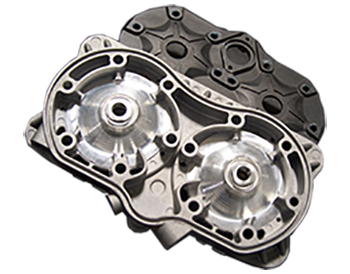What is the real function of the ring?
OK, RINGS?? What are the functions of the piston rings? The most common answer is " To create a seal for compression." OK, the sealing off of the gases for the compression portion of the stroke is a major function of the piston ring, BUT this is not all the ring has to accomplish. Let's look at at what else is going on with the rings.
We'll start from Bottom Dead Center (BDC). At BDC, the crankcase is highly pressurized, the tuned pipe is sucking its hardest ,and the cylinder is filling with the fresh charge via the transfer tunnels. The ring has, hopefully, collected a bit of oil from the cylinder wall and is still transferring heat to the cylinder wall. The piston now begins its race towards Top Dead Center (TDC), the ring's radial tension is keeping it as tight against the cylinder wall as it can. The ring is collecting oil from the cylinder wall and getting ready for the compression portion of the stroke. Once the exhaust port has been closed, (controlled by the piston crown edge, or in the case of pistons fitted with a Dykes ring, the ring itself controls port timing), the ring is retaining oil to help with the compression seal, as well as lubrication. The gas pressures from the compressing gases keep the ring tightly sealed against the cylinder wall.
- As the piston approaches TDC, cylinder pressures are building rapidly, the piston crown is getting very hot, and the ring is doing its best not to allow any of the pressures to blow past it. Then combustion occurs (hopefully at about 11-14 degrees ATDC). The ring now takes on its role as a heat transfer. The crown temps are very high and rising and if these temps do not get reduced the aluminum piston will surely melt. The ring will try and absorb as much of this heat as it can and transfer it to the cylinder walls where it can be dissipated . Ridding the piston of these high temperatures is a very important function of the piston ring.
The style of ring, number of rings, and its location on the piston is very important in assuring that this heat dissipation successfully takes place.
Now, the piston is back at BDC and it all starts over again.
The piston is subject to more abuse then any other part of the 2 stroke engine. It is constantly being pushed on, sucked on, fired on, squeezed on.... well, you get my point.
It is the weakest link in the engine.
Over the last decade or so, advances have been made in piston technology. It has been found that adding Silicon to the Aluminum will reduce piston expansion caused by the extreme heat that is present within an engine. This reduction in thermal expansion reduced piston seizures. Silicone also adds strength to the aluminum and reduces wear.
Pistons are often though of as being a perfectly round cylinder. In actuality, pistons are tapered from the top to the bottom. Why?... Well, different parts of the piston are subject to different levels of heat and since heat tends to expand metals, then it stands to reason, that the areas which are subjected to more heat will expand more then the areas that are subjected to less heat. The top of the piston is obviously subjected to the most amount of heat, as well as pressure, and therefore; will expand more.
Pistons are not only tapered, but oval ground at the skirt. Once again, this is to accommodate the different temperatures that are present on different parts of the piston.
So, when measuring a piston for wear, one needs to measure on the skirt faces at the widest point which is always below the wrist pin. Measuring anywhere, but the widest point will give an inaccurate measurement


